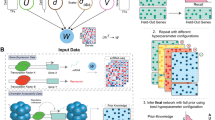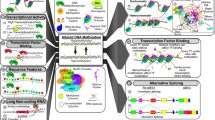Abstract
Purpose
To identify genes that are differently expressed in osteoporotic and non-osteoporotic human bone and to describe the relationships between these genes using multivariate data analysis.
Methods
Seven bone tissue samples from postmenopausal osteoporotic patients and 10 bone tissue samples from postmenopausal non-osteoporotic women were examined in our study. Messenger RNA was prepared from each sample and reverse transcribed to cDNA. The expression differences of 87 selected genes were analyzed in a Taqman probe-based quantitative real-time RT-PCR system.
Results
A Mann-Whitney U-test indicated significant differences in the expression of nine genes (p ≤ 0.05). Seven of these nine genes–ALPL, COL1A1, MMP2, MMP13, MMP9, PDGFA, NFKB1—were significantly downregulated in the bone tissue of osteoporotic women, while CD36 and TWIST2 were significantly upregulated in osteoporotic patients. Principal components analysis was used to evaluate data structure and the relationship between osteoporotic and non-osteoporotic phenotypes based on the multiple mRNA expression profiles of 78 genes. Canonical variates analysis demonstrated further that osteoporotic and non-osteoporotic tissues can be distinguished by expression analysis of genes coding growth factors/non-collagen matrix molecules, and genes belonging to the canonical TGFB pathway.
Conclusion
Significant differences observed in gene expression profiles of osteoporotic and non-osteoporotic human bone tissues provide further insight into the pathogenesis of this disease. Characterization of the differences between osteoporotic and non-osteoporotic bones by expression profiling will contribute to the development of diagnostic tools in the future.




Similar content being viewed by others
References
Prentice A (2001) The relative contribution of diet and genotype to bone development. Proc Nutr Soc 60:45–52
Lane NE (2006) Epidemiology, etiology, and diagnosis of osteoporosis. Am J Obstet Gynecol 194:S3–11
Ralston SH (2005) Genetic determinants of osteoporosis. Curr Opin Rheumatol 17:475–479
Zajickova K, Zofkova I (2003) Osteoporosis: Genetic analysis of multifactorial disease. Endocr Regul 37:31–44
Rizzoli R, Bonjour JP, Ferrari SL (2001) Osteoporosis, genetics and hormones. J Mol Endocrinol 26:79–94
Dvornyk V, Recker RR, Deng HW (2003) Gene expression studies of osteoporosis: Implications for microarray research. Osteoporos Int 14:451–461
Ralston SH (1994) Analysis of gene expression in human bone biopsies by polymerase chain reaction: Evidence for enhanced cytokine expression in postmenopausal osteoporosis. J Bone Miner Res 9:883–890
Abrahamsen B, Shalhoub V, Larson EK, Eriksen EF, Beck-Nielsen H, Marks SC Jr (2000) Cytokine RNA levels in transiliac bone biopsies from healthy early postmenopausal women. Bone 26:137–145
Kellgren JH, Lawrence JS (1957) Radiological assessment of osteo-arthrosis. Ann Rheum Dis 16:494–502
Jolliffe I (1986) Principal component analysis. Springer, Berlin Heidelberg New York
Podani J (2000) Introduction to the exploration of multivariate biological data. Backhuys, Leiden
Raychaudhuri S, Stuart JM, Altman RB (2000) Principal components analysis to summarize microarray experiments: Application to sporulation time series. Pac Symp Biocomput [2000]:455–466
Yeung KY, Ruzzo WL (2001) Principal component analysis for clustering gene expression data. Bioinformatics 17:763–774
Dai JJ, Lieu L, Rocke D (2006) Dimension reduction for classification with gene expression microarray data. Stat Appl Genet Mol Biol 5:article 6
Cattell R (1966) The scree test for the number of factors. Multivar Behav Res 1:140–161
Podani J (2001) SYN-TAX 2000: User’s manual. Scientia, Budapest
Kawabata M, Imamura T, Miyazono K (1998) Signal transduction by bone morphogenetic proteins. Cytokine Growth Factor Rev 9:49–61
Gazzerro E, Canalis E (2006) Bone morphogenetic proteins and their antagonists. Rev Endocr Metab Disord 7:51–65
Turner RT, Riggs BL, Spelsberg TC (1994) Skeletal effects of estrogen. Endocr Rev 15:275–300
Manolagas SC, Kousteni S, Jilka RL (2002) Sex steroids and bone. Recent Prog Horm Res 57:385–409
Christenson RH (1997) Biochemical markers of bone metabolism: An overview. Clin Biochem 30:573–593
Vega D, Maalouf NM, Sakhaee K (2007) The role of RANK/RANKL/OPG: Clinical implications. J Clin Endocrinol Metab 92(12):4514–4521
Page-McCaw A, Ewald AJ, Werb Z (2007) Matrix metalloproteinases and the regulation of tissue remodelling. Nat Rev Mol Cell Biol 8:221–233
Torricelli P, Fini M, Giavaresi G, Giardino R (2002) Human osteoblast cultures from osteoporotic and healthy bone: Biochemical markers and cytokine expression in basal conditions and in response to 1,25(OH)2D3. Artif Cells Blood Substit Immobil Biotechnol 30:219–227
Mueller SM, Glowacki J (2001) Age-related decline in the osteogenic potential of human bone marrow cells cultured in three-dimensional collagen sponges. J Cell Biochem 82:583–590
Rodriguez JP, Montecinos L, Rios S, Reyes P, Martinez J (2000) Mesenchymal stem cells from osteoporotic patients produce a type I collagen-deficient extracellular matrix favoring adipogenic differentiation. J Cell Biochem 79:557–565
Abdallah BM, Haack-Sorensen M, Fink T, Kassem M (2006) Inhibition of osteoblast differentiation but not adipocyte differentiation of mesenchymal stem cells by sera obtained from aged females. Bone 39:181–188
Cao J, Venton L, Sakata T, Halloran BP (2003) Expression of RANKL and OPG correlates with age-related bone loss in male C57BL/6 mice. J Bone Miner Res 18:270–277
Carron JA, Wagstaff SC, Gallagher JA, Bowler WB (2000) A CD36-binding peptide from thrombospondin-1 can stimulate resorption by osteoclasts in vitro. Biochem Biophys Res Commun 270:1124–1127
Calvo D, Gomez-Coronado D, Suarez Y, Lasuncion MA, Vega MA (1998) Human CD36 is a high affinity receptor for the native lipoproteins HDL, LDL, and VLDL. J Lipid Res 39:777–788
Kawaguchi H, Akune T, Yamaguchi M, Ohba S, Ogata N, Chung UI, Kubota N, Terauchi Y, Kadowaki T, Nakamura K (2005) Distinct effects of PPARgamma insufficiency on bone marrow cells, osteoblasts, and osteoclastic cells. J Bone Miner Metab 23:275–279
Moerman EJ, Teng K, Lipschitz DA, Lecka-Czernik B (2004) Aging activates adipogenic and suppresses osteogenic programs in mesenchymal marrow stroma/stem cells: The role of PPAR-gamma2 transcription factor and TGF-beta/BMP signaling pathways. Aging Cell 3:379–389
Aitman TJ, Glazier AM, Wallace CA, Cooper LD, Norsworthy PJ, Wahid FN, Al-Majali KM, Trembling PM, Mann CJ, Shoulders CC, Graf D, St Lezin E, Kurtz TW, Kren V, Pravenec M, Ibrahimi A, Abumrad NA, Stanton LW, Scott J (1999) Identification of Cd36 (Fat) as an insulin-resistance gene causing defective fatty acid and glucose metabolism in hypertensive rats. Nat Genet 21:76–83
Nagy L, Tontonoz P, Alvarez JG, Chen H, Evans RM (1998) Oxidized LDL regulates macrophage gene expression through ligand activation of PPARgamma. Cell 93:229–240
Tamura M, Noda M (1999) Identification of DERMO-1 as a member of helix-loop-helix type transcription factors expressed in osteoblastic cells. J Cell Biochem 72:167–176
Gong XQ, Li L (2002) Dermo-1, a multifunctional basic helix-loop-helix protein, represses MyoD transactivation via the HLH domain, MEF2 interaction, and chromatin deacetylation. J Biol Chem 277:12310–12317
Lee MS, Lowe G, Flanagan S, Kuchler K, Glackin CA (2000) Human Dermo-1 has attributes similar to twist in early bone development. Bone 27:591–602
Schroeder TM, Westendorf JJ (2005) Histone deacetylase inhibitors promote osteoblast maturation. J Bone Miner Res 20:2254–2263
Leeman MF, Curran S, Murray GI (2002) The structure, regulation, and function of human matrix metalloproteinase-13. Crit Rev Biochem Mol Biol 37:149–166
Fridman R, Toth M, Pena D, Mobashery S (1995) Activation of progelatinase B (MMP-9) by gelatinase A (MMP-2). Cancer Res 55:2548–2555
Knauper V, Smith B, Lopez-Otin C, Murphy G (1997) Activation of progelatinase B (proMMP-9) by active collagenase-3 (MMP-13). Eur J Biochem/FEBS 248:369–373
Hatori K, Sasano Y, Takahashi I, Kamakura S, Kagayama M, Sasaki K (2004) Osteoblasts and osteocytes express MMP2 and -8 and TIMP1, -2, and -3 along with extracellular matrix molecules during appositional bone formation. Anat Rec A 277:262–271
Filanti C, Dickson GR, Di Martino D, Ulivi V, Sanguineti C, Romano P, Palermo C, Manduca P (2000) The expression of metalloproteinase-2, -9, and -14 and of tissue inhibitors-1 and -2 is developmentally modulated during osteogenesis in vitro, the mature osteoblastic phenotype expressing metalloproteinase-14. J Bone Miner Res 15:2154–2168
Engsig MT, Chen QJ, Vu TH, Pedersen AC, Therkidsen B, Lund LR, Henriksen K, Lenhard T, Foged NT, Werb Z, Delaisse JM (2000) Matrix metalloproteinase 9 and vascular endothelial growth factor are essential for osteoclast recruitment into developing long bones. J Cell Biol 151:879–889
Rydziel S, Shaikh S, Canalis E (1994) Platelet-derived growth factor-AA and -BB (PDGF-AA and -BB) enhance the synthesis of PDGF-AA in bone cell cultures. Endocrinology 134:2541–2546
Hock JM, Canalis E (1994) Platelet-derived growth factor enhances bone cell replication, but not differentiated function of osteoblasts. Endocrinology 134:1423–1428
Fiedler J, Etzel N, Brenner RE (2004) To go or not to go: Migration of human mesenchymal progenitor cells stimulated by isoforms of PDGF. J Cell Biochem 93:990–998
Tanaka H, Wakisaka A, Ogasa H, Kawai S, Liang CT (2002) Effect of IGF-I and PDGF administered in vivo on the expression of osteoblast-related genes in old rats. J Endocrinol 174:63–70
Wada T, Nakashima T, Hiroshi N, Penninger JM (2006) RANKL-RANK signaling in osteoclastogenesis and bone disease. Trends Mol Med 12:17–25
Park H, Jung YK, Park OJ, Lee YJ, Choi JY, Choi Y (2005) Interaction of Fas ligand and Fas expressed on osteoclast precursors increases osteoclastogenesis. J Immunol 175:7193–201
Ozeki N, Mogi M, Nakamura H, Togari A (2002) Differential expression of the Fas-Fas ligand system on cytokine-induced apoptotic cell death in mouse osteoblastic cells. Arch Oral Biol 47:511–517
Atkins GJ, Bouralexis S, Evdokiou A, Hay S, Labrinidis A, Zannettino AC, Haynes DR, Findlay DM (2002) Human osteoblasts are resistant to Apo2L/TRAIL-mediated apoptosis. Bone 31:448–56
Roux S, Lambert-Comeau P, Saint-Pierre C, Lepine M, Sawan B, Parent JL (2005) Death receptors, Fas and TRAIL receptors, are involved in human osteoclast apoptosis. Biochem Biophys Res Commun 333:42–50
Acknowledgment
This work was supported by grants NKFP-1A/007/2004, NKFP-1A/002/2004 from the National Research and Technological Office (NKTH) of Hungary, as well as by research grant ETT 022/2006 from the Ministry of Health, Hungary. J.P. was supported by a Hungarian Scientific Research Fund (OTKA) grant no. NI 68218. The authors thank Dr. Attila Tóth (Dresden University of Technology, Germany) for critically reading this manuscript.
Author information
Authors and Affiliations
Corresponding author
Additional information
Bernadett Balla1 and János P. Kósa1 contributed equally to this work.
Rights and permissions
About this article
Cite this article
Balla, B., Kósa, J.P., Kiss, J. et al. Different Gene Expression Patterns in the Bone Tissue of Aging Postmenopausal Osteoporotic and Non-osteoporotic Women. Calcif Tissue Int 82, 12–26 (2008). https://doi.org/10.1007/s00223-007-9092-3
Received:
Accepted:
Published:
Issue Date:
DOI: https://doi.org/10.1007/s00223-007-9092-3




